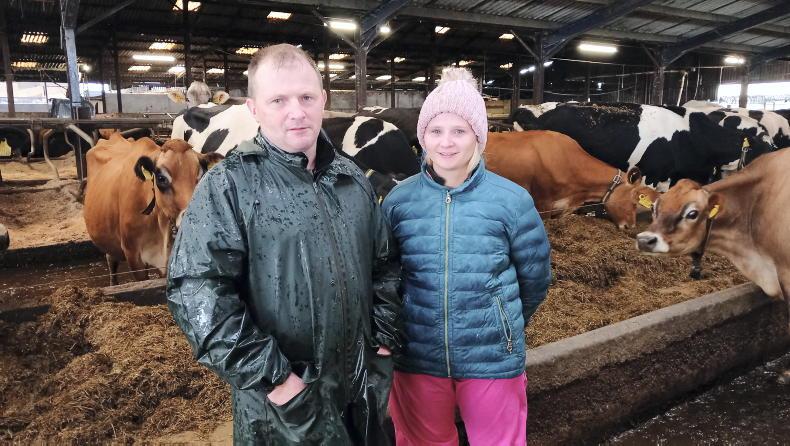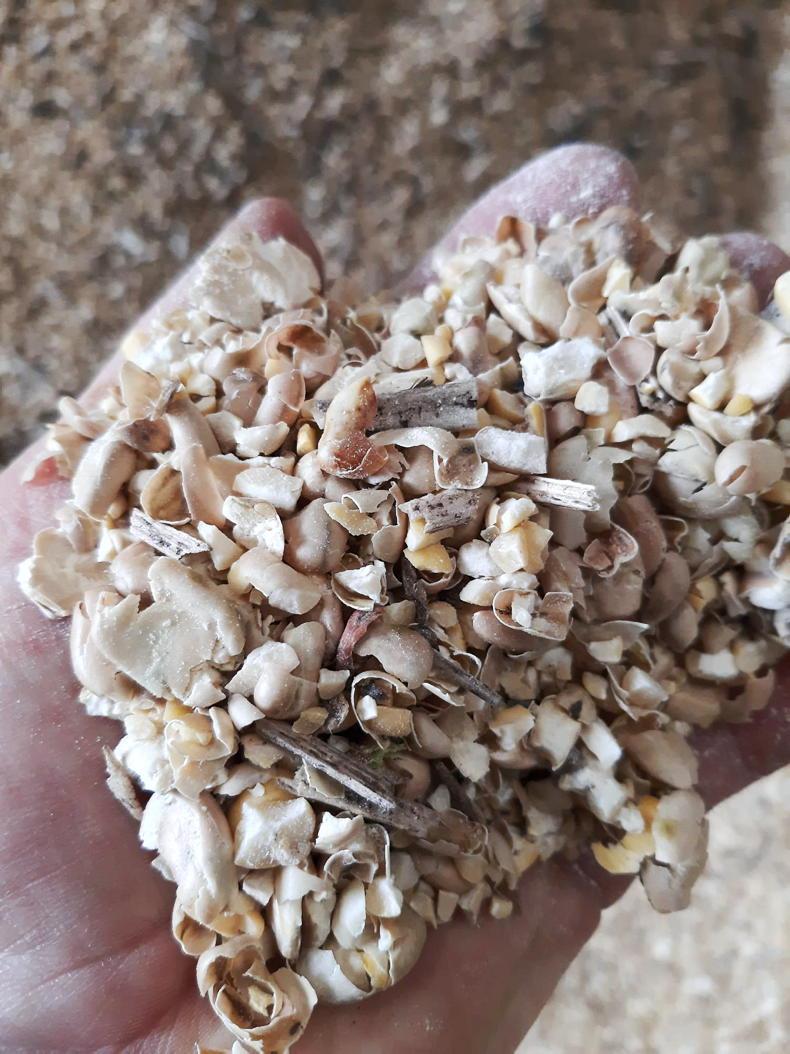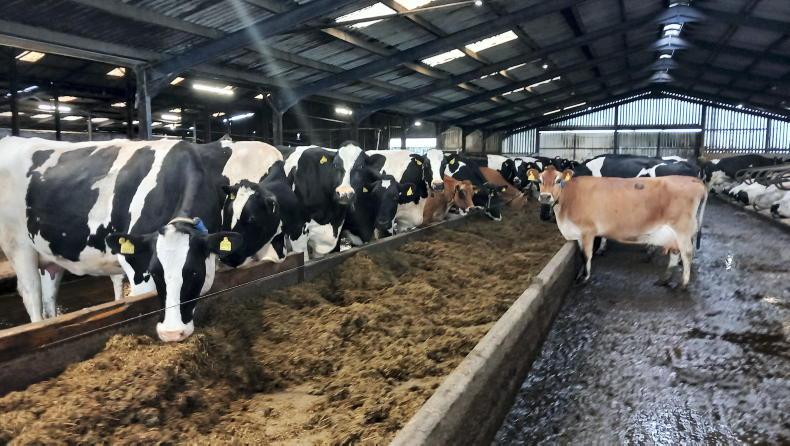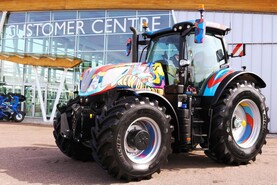English dairy farmer Ian Bowness keeps bought-in feed to a minimum by growing cereal and protein crops for his 270-cow herd.
The farm extends to 630 acres across three blocks and is located in Cumbria in the northwest of England. Around half of the land area is owned and the other half rented.
There is a mix of enterprises on the farm. Aside from the dairy and arable operations, there is flock of 80 Mule ewes and all beef-sired heifers from the dairy herd are kept through to beef.
Ian grows winter wheat and spring beans, with both crops combined and used in the total mixed ration (TMR) for the dairy herd. He also grows some spring wheat which is harvested as wholecrop silage for the TMR.
“We grow a bit of winter barley which is combined and fed early on in the year. It can be useful because it is in the shed a few weeks before the main wheat crop,” he said.

Ian Bowness with his daughter, Amy, on the family farm near Wigton, Cumbria.
The dairy herd has an average milk yield of 9,000 litres. Cows are mostly Holstein, although around of 10% of the herd are Jersey.
“We have started using Fleckvieh sires on the Holstein cows to get hybrid vigour and hopefully improve longevity. We aren’t sure yet if we will stick with the first cross or maybe we will go to a three or four way cross,” Ian said.
There are no in-parlour or out-of-parlour feeders on the farm. Cows get out to grass by day during the grazing season but are housed by night and offered TMR as a buffer feed.
Around half of the farm is grassland and the other half is in either beans, wheat, or barley. Ian points out that beans are a useful break crop in his arable rotation, and they also tick several boxes on the sustainability front.
Firstly, beans are his main protein source in the TMR, so he does not have to buy in imported soya. Also, the crop is a legume, so it fixes nitrogen from the air and does not require applications of nitrogen fertiliser.
“The beans are direct-drilled, so there is no carbon released from ploughing and there is an incredible amount of bees and other pollinators in the fields when the crop flowers,” Ian said.

Crushed beans for inclusion in the TMR.
The arable element of the business lends itself well to the dispersed farm layout and having grassland for either grazing livestock or silage also suits an arable rotation.
Weather challenge
Ian faces the same challenges with weather as many NI farmers. His farm gets up to 1,200mm of rainfall annually and windows to get silage made or arable crops harvested can be narrow.
“The system we run is not simple. When you think about it, there is nothing simpler than a lorry turning up and blowing in all the feed you want,” he said.
To get consistency and quality in the TMR, all combined wheat is treated with Home n’ Dry, a urea-based additive that effectively sterilises the crop. The resultant feed is stable, has increased protein content and has a high pH which helps buffer the cow’s rumen.
“You end up with a feed that is 55% starch and 15.5% crude protein. It is mixed after harvest so I have 300 tonnes or so in the shed ready for feeding throughout the year,” Ian explained.
The spring beans this year were direct-drilled on 18 March and were harvested on 20 September. The beans were dried on a drying floor after harvest and are crushed as needed during the year.

Fleckvieh sires have been used on Holstein cows to improve longevity.
Some extra feed is bought in on the Bowness farm for the TMR, such as caustic wheat and brewers grains from a distillery in Scotland.
The dairy herd is housed full time at present and is offered a ration made up of 4.5kg brewers grains, 3kg urea treated wheat, 3kg caustic wheat, 2kg beans, 6kg wholecrop spring wheat and 40kg of first-cut silage.
Like many NI farms, wet weather in mid-May meant this year’s first cut turned out disappointing on the Bowness farm. Ian says there was very little wilt which meant the crop analysed at 20% dry matter, although subsequent cuts turned out to be much better quality.
Calving pattern
Ian is moving away from an all-year-round calving system to a more compact calving spread weighted toward the summer months.
“This is not an early farm, so there is no point calving cows in February. We usually get cows out to grass during the day from mid-April and the grazing season tends to finish in early or mid-October,” he said.
Ian wants to tighten the calving spread as it should simplify his system and make it more labour efficient. He also acknowledges that he served cows for too long in the past, so low fertility cows got too many chances to stay in the herd.
Calving index is currently 395 days and the aim is to bring this down as the herd moves toward a tighter calving spread.
He does not want to move to an autumn system because calving would clash with harvest in his arable enterprise. Also, unlike dairy co-ops in NI, Ian’s processor Arla has no bonus payment for producing milk during winter months.

Fleckvieh sires have been used on Holstein cows to improve longevity.
BPS changes are dawning on English farmers
Ian Bowness is county chair of the National Farmers’ Union (NFU) in Cumbria and is well briefed on current affairs within English agriculture.
He sits on the NFU national council where the Environmental Land Management Scheme (ELMS) has been a major talking point in recent weeks.
ELMS is to be the main replacement for the Basic Payment Scheme (BPS) in England. The plan is for English BPS payments to be gradually phased out from 2021 to 2027, while ELMS, which will mainly be focused on delivering environmental measures, is rolled out in stages.
“The whole impact of the change in support has started to dawn on people, especially on beef and sheep farms where BPS could be more than 100% of your profit,” Ian said.
The current Liz Truss-led government recently announced that all farm policies in England are to be “rapidly reviewed”.
This was broadly welcomed by the farm lobby, although environmental groups were critical due to concerns that ELMS could move away from its strong environmental focus.
Bewildered
Ian is bewildered by most of the commentary around BPS and ELMS. He said environmental groups and politicians do not realise that BPS “is not money for doing nothing” as farmers must meet strict cross compliance and land eligibility rules to draw down payments.
“If direct payments are cut, then the price of certain foods, like beef and lamb, will have to increase in the shops if farmers are to stay profitable. I don’t think a lot of people realise that,” he said.
“The whole thing seems to be paused and it is very uncertain what lays ahead. There is no long-term strategy for farm policy within government because each new minister that comes in every few years wants to meddle with it,” Ian said.
English dairy farmer Ian Bowness keeps bought-in feed to a minimum by growing cereal and protein crops for his 270-cow herd.
The farm extends to 630 acres across three blocks and is located in Cumbria in the northwest of England. Around half of the land area is owned and the other half rented.
There is a mix of enterprises on the farm. Aside from the dairy and arable operations, there is flock of 80 Mule ewes and all beef-sired heifers from the dairy herd are kept through to beef.
Ian grows winter wheat and spring beans, with both crops combined and used in the total mixed ration (TMR) for the dairy herd. He also grows some spring wheat which is harvested as wholecrop silage for the TMR.
“We grow a bit of winter barley which is combined and fed early on in the year. It can be useful because it is in the shed a few weeks before the main wheat crop,” he said.

Ian Bowness with his daughter, Amy, on the family farm near Wigton, Cumbria.
The dairy herd has an average milk yield of 9,000 litres. Cows are mostly Holstein, although around of 10% of the herd are Jersey.
“We have started using Fleckvieh sires on the Holstein cows to get hybrid vigour and hopefully improve longevity. We aren’t sure yet if we will stick with the first cross or maybe we will go to a three or four way cross,” Ian said.
There are no in-parlour or out-of-parlour feeders on the farm. Cows get out to grass by day during the grazing season but are housed by night and offered TMR as a buffer feed.
Around half of the farm is grassland and the other half is in either beans, wheat, or barley. Ian points out that beans are a useful break crop in his arable rotation, and they also tick several boxes on the sustainability front.
Firstly, beans are his main protein source in the TMR, so he does not have to buy in imported soya. Also, the crop is a legume, so it fixes nitrogen from the air and does not require applications of nitrogen fertiliser.
“The beans are direct-drilled, so there is no carbon released from ploughing and there is an incredible amount of bees and other pollinators in the fields when the crop flowers,” Ian said.

Crushed beans for inclusion in the TMR.
The arable element of the business lends itself well to the dispersed farm layout and having grassland for either grazing livestock or silage also suits an arable rotation.
Weather challenge
Ian faces the same challenges with weather as many NI farmers. His farm gets up to 1,200mm of rainfall annually and windows to get silage made or arable crops harvested can be narrow.
“The system we run is not simple. When you think about it, there is nothing simpler than a lorry turning up and blowing in all the feed you want,” he said.
To get consistency and quality in the TMR, all combined wheat is treated with Home n’ Dry, a urea-based additive that effectively sterilises the crop. The resultant feed is stable, has increased protein content and has a high pH which helps buffer the cow’s rumen.
“You end up with a feed that is 55% starch and 15.5% crude protein. It is mixed after harvest so I have 300 tonnes or so in the shed ready for feeding throughout the year,” Ian explained.
The spring beans this year were direct-drilled on 18 March and were harvested on 20 September. The beans were dried on a drying floor after harvest and are crushed as needed during the year.

Fleckvieh sires have been used on Holstein cows to improve longevity.
Some extra feed is bought in on the Bowness farm for the TMR, such as caustic wheat and brewers grains from a distillery in Scotland.
The dairy herd is housed full time at present and is offered a ration made up of 4.5kg brewers grains, 3kg urea treated wheat, 3kg caustic wheat, 2kg beans, 6kg wholecrop spring wheat and 40kg of first-cut silage.
Like many NI farms, wet weather in mid-May meant this year’s first cut turned out disappointing on the Bowness farm. Ian says there was very little wilt which meant the crop analysed at 20% dry matter, although subsequent cuts turned out to be much better quality.
Calving pattern
Ian is moving away from an all-year-round calving system to a more compact calving spread weighted toward the summer months.
“This is not an early farm, so there is no point calving cows in February. We usually get cows out to grass during the day from mid-April and the grazing season tends to finish in early or mid-October,” he said.
Ian wants to tighten the calving spread as it should simplify his system and make it more labour efficient. He also acknowledges that he served cows for too long in the past, so low fertility cows got too many chances to stay in the herd.
Calving index is currently 395 days and the aim is to bring this down as the herd moves toward a tighter calving spread.
He does not want to move to an autumn system because calving would clash with harvest in his arable enterprise. Also, unlike dairy co-ops in NI, Ian’s processor Arla has no bonus payment for producing milk during winter months.

Fleckvieh sires have been used on Holstein cows to improve longevity.
BPS changes are dawning on English farmers
Ian Bowness is county chair of the National Farmers’ Union (NFU) in Cumbria and is well briefed on current affairs within English agriculture.
He sits on the NFU national council where the Environmental Land Management Scheme (ELMS) has been a major talking point in recent weeks.
ELMS is to be the main replacement for the Basic Payment Scheme (BPS) in England. The plan is for English BPS payments to be gradually phased out from 2021 to 2027, while ELMS, which will mainly be focused on delivering environmental measures, is rolled out in stages.
“The whole impact of the change in support has started to dawn on people, especially on beef and sheep farms where BPS could be more than 100% of your profit,” Ian said.
The current Liz Truss-led government recently announced that all farm policies in England are to be “rapidly reviewed”.
This was broadly welcomed by the farm lobby, although environmental groups were critical due to concerns that ELMS could move away from its strong environmental focus.
Bewildered
Ian is bewildered by most of the commentary around BPS and ELMS. He said environmental groups and politicians do not realise that BPS “is not money for doing nothing” as farmers must meet strict cross compliance and land eligibility rules to draw down payments.
“If direct payments are cut, then the price of certain foods, like beef and lamb, will have to increase in the shops if farmers are to stay profitable. I don’t think a lot of people realise that,” he said.
“The whole thing seems to be paused and it is very uncertain what lays ahead. There is no long-term strategy for farm policy within government because each new minister that comes in every few years wants to meddle with it,” Ian said.










 This is a subscriber-only article
This is a subscriber-only article











SHARING OPTIONS: